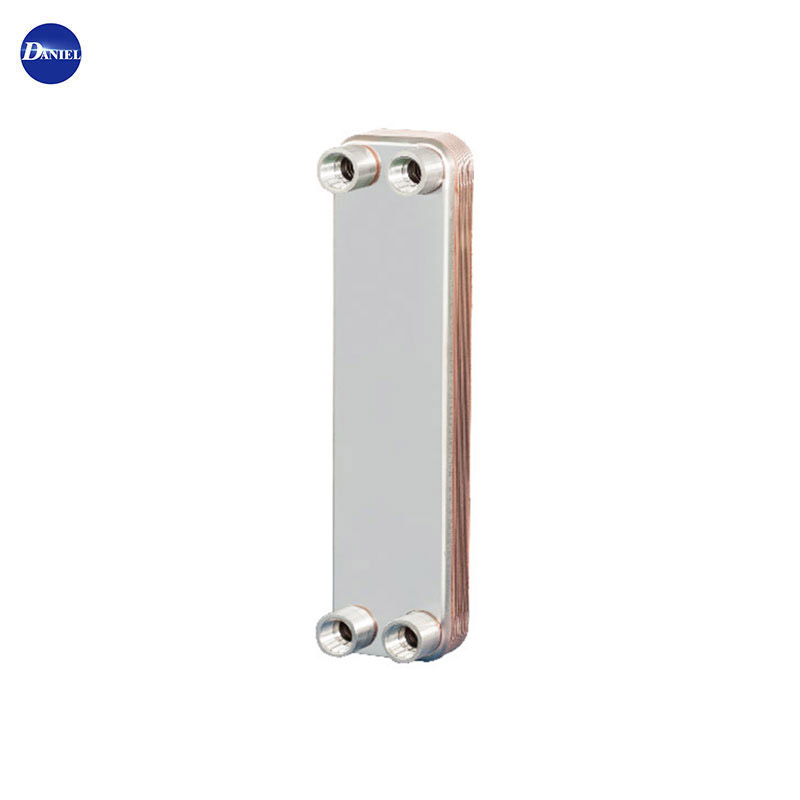What is a Brazed Plate Heat Exchanger?
2025-09-08
Welcome to the world of efficient and compact heat exchange. If you're involved in industries like HVAC, refrigeration, or energy recovery, you've likely encountered the term Brazed Plate Heat Exchanger. This article, brought to you by the experts at Daniel, will serve as your comprehensive guide. We will delve into what exactly a brazed plate heat exchanger is, how it works, its numerous advantages, and its wide-ranging applications. Most importantly, we will provide a detailed look at the technical specifications and product parameters that define a high-quality unit, helping you make an informed decision for your specific needs.
A Brazed Plate Heat Exchanger (BPHE) is a highly efficient, compact device designed to transfer heat between two fluids without mixing them. Constructed from multiple thin, corrugated metal plates brazed together into a single, robust assembly, these units are engineered for superior thermal performance and reliability. The brazing process, typically using copper or nickel as the braze material, creates a permanent bond between the plates, making the heat exchanger exceptionally durable and capable of withstanding high pressures and temperatures.
How Does a Brazed Plate Heat Exchanger Work?
The fundamental operation is elegant in its simplicity. The corrugated plates are assembled to form a series of intricate channels. One fluid flows through every second channel (the hot side), while the second fluid flows through the alternating channels (the cold side), in a counter-current flow arrangement. The corrugated pattern of the plates induces intense turbulence in the fluids. This turbulence maximizes heat transfer efficiency by ensuring optimal contact with the plate surfaces and minimizing fouling. Heat is conducted through the thin metal plates from the warmer fluid to the cooler one, achieving significant temperature changes in a very small physical footprint.
Key Advantages of Choosing a Daniel Brazed Plate Heat Exchanger
Why has the Brazed Plate Heat Exchanger become the industry standard for so many applications? The benefits are clear and substantial:
-
Exceptional Efficiency: The turbulent flow and large surface area created by the plate design enable heat transfer rates that are 3 to 5 times higher than traditional shell-and-tube heat exchangers.
-
Compact and Lightweight Design: Their small size and weight make them ideal for applications where space is at a premium, allowing for easier installation and integration into existing systems.
-
High Pressure and Temperature Resistance: The brazed construction creates a strong unit capable of handling working pressures up to 45 bar and temperatures up to 200°C (392°F), depending on the model and materials.
-
Cost-Effective: Reduced material requirements and lower operational costs due to high efficiency translate into significant savings over the lifecycle of the product.
-
Low Maintenance: The single-block, brazed construction has no gaskets or framing parts that require tightening or replacement, eliminating common failure points and maintenance headaches.
-
Long Service Life: Manufactured from high-quality stainless steel and brazed with pure copper or nickel, Daniel BPHEs are built to resist corrosion and erosion, ensuring years of reliable operation.
Primary Applications of Brazed Plate Heat Exchangers
The versatility of the Brazed Plate Heat Exchanger allows it to serve a multitude of sectors:
-
HVAC: Domestic hot water heating, condenser cooling, and heat pump systems.
-
Refrigeration: Serving as evaporators, condensers, and oil coolers in commercial refrigeration units.
-
Industrial Processes: Cooling hydraulic oil, machinery, and lasers; heating and cooling in various chemical processes.
-
Energy Recovery: Capturing waste heat from ventilation systems or process water for reuse.
Detailed Product Parameters and Technical Specifications
At Daniel, we pride ourselves on transparency and engineering excellence. Our range of Brazed Plate Heat Exchangers is designed to meet the most demanding requirements. Below, you will find a detailed breakdown of our standard product parameters.
Standard Material Composition:
-
Plates: AISI 316 Stainless Steel
-
Brazing Material: 99.9% Pure Copper (Standard), Nickel (for corrosive applications or compatibility with ammonia)
Key Parameter List:
Our BPHEs are characterized by several critical performance and physical metrics:
-
Maximum Design Pressure: The highest pressure the unit is designed to withstand continuously.
-
Maximum Design Temperature: The highest fluid temperature the unit is designed to handle.
-
Heat Transfer Area: The total surface area available for heat exchange, measured in square meters (m²).
-
Number of Plates: The total count of heat transfer plates within the assembly.
-
Port Size: The diameter of the inlet and outlet connections, determining pipe compatibility.
-
Flow Rate Range: The recommended range of volumetric flow for optimal performance.
-
Heat Capacity: The amount of heat the unit can transfer, measured in kilowatts (kW).
Daniel Brazed Plate Heat Exchanger Technical Data Table
The following table provides a snapshot of specifications for a selection of our popular models. Please note that this is a general guide, and exact performance will depend on operating conditions.
| Model Series | Max. Design Pressure (Bar) | Max. Design Temp. (°C) | Heat Transfer Area (m²) | Number of Plates | Connection Port (Inch) | Approx. Heat Capacity Range (kW) |
|---|---|---|---|---|---|---|
| Daniel-BPHE-10 | 30 | 200 | 0.10 | 20 | 3/8" | 5 - 15 |
| Daniel-BPHE-30 | 30 | 200 | 0.30 | 40 | 3/4" | 15 - 45 |
| Daniel-BPHE-50 | 30 | 200 | 0.50 | 60 | 1" | 40 - 80 |
| Daniel-BPHE-80 | 30 | 200 | 0.80 | 80 | 1 1/4" | 70 - 120 |
| Daniel-BPHE-100 | 30 | 200 | 1.00 | 100 | 1 1/2" | 90 - 150 |
| Daniel-BPHE-Ni-50 | 25 | 200 | 0.50 | 60 | 1" | 35 - 75 |
Specifications are subject to change based on continuous product improvement. The heat capacity range is indicative and based on standard water/water applications.
Choosing the Right Brazed Plate Heat Exchanger
Selecting the correct Brazed Plate Heat Exchanger is crucial for system efficiency and longevity. Key considerations include:
-
Application Requirements: Define the primary duty (heating, cooling, evaporating, condensing).
-
Fluid Properties: Understand the composition, viscosity, and corrosiveness of both fluids.
-
Flow Rates: Determine the volumetric flow rate for both the hot and cold sides.
-
Temperature Program: Identify the inlet and outlet temperatures for both circuits.
-
Pressure Drop: Consider the allowable pressure loss on each side of the exchanger.
-
Material Compatibility: Ensure the plate and brazing materials are compatible with your fluids to prevent corrosion.
For complex selections, our engineering team is always ready to assist you with precise calculations.
In my two decades in this industry, I have seen firsthand the transformative impact that a high-quality, correctly specified Brazed Plate Heat Exchanger can have on a system's performance and energy consumption. At Daniel, we don't just sell components; we provide engineered solutions backed by rigorous testing and a commitment to quality. I am confident that our expertise and product range can meet and exceed your expectations. To discuss your specific application, receive a detailed quotation, or get expert advice from our team, please do not hesitate to reach out to us directly at [email protected]. Let us help you build a more efficient and reliable system.



